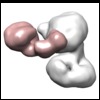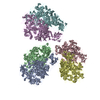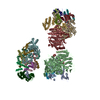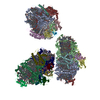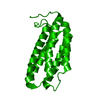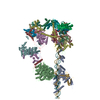+ Open data
Open data
- Basic information
Basic information
| Entry | Database: EMDB / ID: EMD-3278 | |||||||||
|---|---|---|---|---|---|---|---|---|---|---|
| Title | Electron microscopy of the SMG1C-DHX34 complex | |||||||||
 Map data Map data | Reconstruction of SMG1C-DHX34 | |||||||||
 Sample Sample |
| |||||||||
 Keywords Keywords | NMD /  SMG1 / SMG8 / SMG9 / PIKK / SMG1 / SMG8 / SMG9 / PIKK /  DHX34 / RNA degradation / DHX34 / RNA degradation /  RNA helicase RNA helicase | |||||||||
| Function / homology |  Function and homology information Function and homology informationRNA helicase activity => GO:0003724 / RNA binding => GO:0003723 / negative regulation of nuclear-transcribed mRNA catabolic process, nonsense-mediated decay / RNA metabolic process / diacylglycerol-dependent serine/threonine kinase activity /  chromatoid body / chromatoid body /  eye development / nuclear-transcribed mRNA catabolic process / eye development / nuclear-transcribed mRNA catabolic process /  regulation of telomere maintenance / regulation of telomere maintenance /  regulation of protein kinase activity ...RNA helicase activity => GO:0003724 / RNA binding => GO:0003723 / negative regulation of nuclear-transcribed mRNA catabolic process, nonsense-mediated decay / RNA metabolic process / diacylglycerol-dependent serine/threonine kinase activity / regulation of protein kinase activity ...RNA helicase activity => GO:0003724 / RNA binding => GO:0003723 / negative regulation of nuclear-transcribed mRNA catabolic process, nonsense-mediated decay / RNA metabolic process / diacylglycerol-dependent serine/threonine kinase activity /  chromatoid body / chromatoid body /  eye development / nuclear-transcribed mRNA catabolic process / eye development / nuclear-transcribed mRNA catabolic process /  regulation of telomere maintenance / regulation of telomere maintenance /  regulation of protein kinase activity / nuclear-transcribed mRNA catabolic process, nonsense-mediated decay / telomeric DNA binding / phosphatidylinositol phosphate biosynthetic process / Nonsense Mediated Decay (NMD) enhanced by the Exon Junction Complex (EJC) / regulation of protein kinase activity / nuclear-transcribed mRNA catabolic process, nonsense-mediated decay / telomeric DNA binding / phosphatidylinositol phosphate biosynthetic process / Nonsense Mediated Decay (NMD) enhanced by the Exon Junction Complex (EJC) /  RNA processing / mRNA export from nucleus / positive regulation of phosphorylation / RNA processing / mRNA export from nucleus / positive regulation of phosphorylation /  brain development / brain development /  heart development / peptidyl-serine phosphorylation / in utero embryonic development / heart development / peptidyl-serine phosphorylation / in utero embryonic development /  RNA helicase activity / protein autophosphorylation / RNA helicase activity / protein autophosphorylation /  RNA helicase / RNA helicase /  non-specific serine/threonine protein kinase / non-specific serine/threonine protein kinase /  protein kinase activity / protein kinase activity /  DNA repair / protein serine kinase activity / protein serine/threonine kinase activity / DNA damage response / protein-containing complex binding / negative regulation of apoptotic process / DNA repair / protein serine kinase activity / protein serine/threonine kinase activity / DNA damage response / protein-containing complex binding / negative regulation of apoptotic process /  ATP hydrolysis activity / ATP hydrolysis activity /  RNA binding / RNA binding /  nucleoplasm / nucleoplasm /  ATP binding / ATP binding /  membrane / identical protein binding / membrane / identical protein binding /  metal ion binding / metal ion binding /  nucleus / nucleus /  cytosol / cytosol /  cytoplasm cytoplasmSimilarity search - Function | |||||||||
| Biological species |   Homo sapiens (human) Homo sapiens (human) | |||||||||
| Method |  single particle reconstruction / single particle reconstruction /  negative staining / Resolution: 20.89 Å negative staining / Resolution: 20.89 Å | |||||||||
 Authors Authors | Melero R / Hug N / Lopez-Perrote A / Yamashita A / Caceres J / Llorca O | |||||||||
 Citation Citation |  Journal: Nat Commun / Year: 2016 Journal: Nat Commun / Year: 2016Title: The RNA helicase DHX34 functions as a scaffold for SMG1-mediated UPF1 phosphorylation. Authors: Roberto Melero / Nele Hug / Andrés López-Perrote / Akio Yamashita / Javier F Cáceres / Oscar Llorca /    Abstract: Nonsense-mediated decay (NMD) is a messenger RNA quality-control pathway triggered by SMG1-mediated phosphorylation of the NMD factor UPF1. In recent times, the RNA helicase DHX34 was found to ...Nonsense-mediated decay (NMD) is a messenger RNA quality-control pathway triggered by SMG1-mediated phosphorylation of the NMD factor UPF1. In recent times, the RNA helicase DHX34 was found to promote mRNP remodelling, leading to activation of NMD. Here we demonstrate the mechanism by which DHX34 functions in concert with SMG1. DHX34 comprises two distinct structural units, a core that binds UPF1 and a protruding carboxy-terminal domain (CTD) that binds the SMG1 kinase, as shown using truncated forms of DHX34 and electron microscopy of the SMG1-DHX34 complex. Truncation of the DHX34 CTD does not affect binding to UPF1; however, it compromises DHX34 binding to SMG1 to affect UPF1 phosphorylation and hence abrogate NMD. Altogether, these data suggest the existence of a complex comprising SMG1, UPF1 and DHX34, with DHX34 functioning as a scaffold for UPF1 and SMG1. This complex promotes UPF1 phosphorylation leading to functional NMD. | |||||||||
| History |
|
- Structure visualization
Structure visualization
| Movie |
 Movie viewer Movie viewer |
|---|---|
| Structure viewer | EM map:  SurfView SurfView Molmil Molmil Jmol/JSmol Jmol/JSmol |
| Supplemental images |
- Downloads & links
Downloads & links
-EMDB archive
| Map data |  emd_3278.map.gz emd_3278.map.gz | 749.1 KB |  EMDB map data format EMDB map data format | |
|---|---|---|---|---|
| Header (meta data) |  emd-3278-v30.xml emd-3278-v30.xml emd-3278.xml emd-3278.xml | 13.6 KB 13.6 KB | Display Display |  EMDB header EMDB header |
| Images |  EMD-3278_SMG1C_DHX34.png EMD-3278_SMG1C_DHX34.png | 104.5 KB | ||
| Archive directory |  http://ftp.pdbj.org/pub/emdb/structures/EMD-3278 http://ftp.pdbj.org/pub/emdb/structures/EMD-3278 ftp://ftp.pdbj.org/pub/emdb/structures/EMD-3278 ftp://ftp.pdbj.org/pub/emdb/structures/EMD-3278 | HTTPS FTP |
-Related structure data
- Links
Links
| EMDB pages |  EMDB (EBI/PDBe) / EMDB (EBI/PDBe) /  EMDataResource EMDataResource |
|---|---|
| Related items in Molecule of the Month |
- Map
Map
| File |  Download / File: emd_3278.map.gz / Format: CCP4 / Size: 1.4 MB / Type: IMAGE STORED AS FLOATING POINT NUMBER (4 BYTES) Download / File: emd_3278.map.gz / Format: CCP4 / Size: 1.4 MB / Type: IMAGE STORED AS FLOATING POINT NUMBER (4 BYTES) | ||||||||||||||||||||||||||||||||||||||||||||||||||||||||||||
|---|---|---|---|---|---|---|---|---|---|---|---|---|---|---|---|---|---|---|---|---|---|---|---|---|---|---|---|---|---|---|---|---|---|---|---|---|---|---|---|---|---|---|---|---|---|---|---|---|---|---|---|---|---|---|---|---|---|---|---|---|---|
| Annotation | Reconstruction of SMG1C-DHX34 | ||||||||||||||||||||||||||||||||||||||||||||||||||||||||||||
| Voxel size | X=Y=Z: 5.68 Å | ||||||||||||||||||||||||||||||||||||||||||||||||||||||||||||
| Density |
| ||||||||||||||||||||||||||||||||||||||||||||||||||||||||||||
| Symmetry | Space group: 1 | ||||||||||||||||||||||||||||||||||||||||||||||||||||||||||||
| Details | EMDB XML:
CCP4 map header:
| ||||||||||||||||||||||||||||||||||||||||||||||||||||||||||||
-Supplemental data
- Sample components
Sample components
-Entire : SMG1C complex, comprising SMG1 kinase, SMG8 and SMG9, bound to th...
| Entire | Name: SMG1C complex, comprising SMG1 kinase, SMG8 and SMG9, bound to the DHX34 helicase |
|---|---|
| Components |
|
-Supramolecule #1000: SMG1C complex, comprising SMG1 kinase, SMG8 and SMG9, bound to th...
| Supramolecule | Name: SMG1C complex, comprising SMG1 kinase, SMG8 and SMG9, bound to the DHX34 helicase type: sample / ID: 1000 Oligomeric state: Heterotetramer of SMG1, SMG8, SMG9 and DHX34 Number unique components: 4 |
|---|---|
| Molecular weight | Theoretical: 770 KDa |
-Macromolecule #1: Serine/threonine-protein kinase SMG1
| Macromolecule | Name: Serine/threonine-protein kinase SMG1 / type: protein_or_peptide / ID: 1 / Name.synonym: SMG-1 / Recombinant expression: Yes |
|---|---|
| Source (natural) | Organism:   Homo sapiens (human) / synonym: Human Homo sapiens (human) / synonym: Human |
| Molecular weight | Theoretical: 410 KDa |
| Recombinant expression | Organism:   Homo sapiens (human) / Recombinant cell: 293T cells Homo sapiens (human) / Recombinant cell: 293T cells |
| Sequence | UniProtKB: Serine/threonine-protein kinase SMG1 GO:  DNA repair, RNA metabolic process, nuclear-transcribed mRNA catabolic process, nonsense-mediated decay, DNA repair, RNA metabolic process, nuclear-transcribed mRNA catabolic process, nonsense-mediated decay,  ATP binding ATP binding |
-Macromolecule #2: SMG8
| Macromolecule | Name: SMG8 / type: protein_or_peptide / ID: 2 / Name.synonym: SMG-8 / Recombinant expression: Yes |
|---|---|
| Source (natural) | Organism:   Homo sapiens (human) / synonym: Human Homo sapiens (human) / synonym: Human |
| Molecular weight | Theoretical: 109 KDa |
| Recombinant expression | Organism:   Homo sapiens (human) / Recombinant cell: 293T cells Homo sapiens (human) / Recombinant cell: 293T cells |
| Sequence | UniProtKB: Nonsense-mediated mRNA decay factor SMG8 GO: nuclear-transcribed mRNA catabolic process, nonsense-mediated decay InterPro: Nonsense-mediated mRNA decay factor SMG8 |
-Macromolecule #3: SMG9
| Macromolecule | Name: SMG9 / type: protein_or_peptide / ID: 3 / Name.synonym: SMG-9 / Recombinant expression: Yes |
|---|---|
| Source (natural) | Organism:   Homo sapiens (human) / synonym: Human Homo sapiens (human) / synonym: Human |
| Molecular weight | Theoretical: 60 KDa |
| Recombinant expression | Organism:   Homo sapiens (human) / Recombinant cell: 293T cells Homo sapiens (human) / Recombinant cell: 293T cells |
| Sequence | UniProtKB: Nonsense-mediated mRNA decay factor SMG9 GO: nuclear-transcribed mRNA catabolic process, nonsense-mediated decay InterPro: P-loop containing nucleoside triphosphate hydrolase, Nonsense-mediated mRNA decay factor SMG8/SMG9 |
-Macromolecule #4: DHX34
| Macromolecule | Name: DHX34 / type: protein_or_peptide / ID: 4 / Recombinant expression: Yes |
|---|---|
| Source (natural) | Organism:   Homo sapiens (human) / synonym: Human Homo sapiens (human) / synonym: Human |
| Molecular weight | Theoretical: 128 KDa |
| Recombinant expression | Organism:   Homo sapiens (human) / Recombinant cell: 293T cells Homo sapiens (human) / Recombinant cell: 293T cells |
| Sequence | UniProtKB: Probable ATP-dependent RNA helicase DHX34 GO: cytoplasm, membrane, ATP binding, RNA helicase activity => GO:0003724, RNA binding => GO:0003723, negative regulation of nuclear-transcribed mRNA catabolic process, nonsense-mediated decay, ...GO:  cytoplasm, cytoplasm,  membrane, membrane,  ATP binding, RNA helicase activity => GO:0003724, RNA binding => GO:0003723, negative regulation of nuclear-transcribed mRNA catabolic process, nonsense-mediated decay, nuclear-transcribed mRNA catabolic process, nuclear-transcribed mRNA catabolic process, nonsense-mediated decay, ATP binding, RNA helicase activity => GO:0003724, RNA binding => GO:0003723, negative regulation of nuclear-transcribed mRNA catabolic process, nonsense-mediated decay, nuclear-transcribed mRNA catabolic process, nuclear-transcribed mRNA catabolic process, nonsense-mediated decay,  RNA processing RNA processingInterPro: DEAD-box helicase, OB fold, Helicase-associated domain, Helicase superfamily 1/2, ATP-binding domain,  Helicase, C-terminal, P-loop containing nucleoside triphosphate hydrolase, INTERPRO: IPR015880 Helicase, C-terminal, P-loop containing nucleoside triphosphate hydrolase, INTERPRO: IPR015880 |
-Experimental details
-Structure determination
| Method |  negative staining negative staining |
|---|---|
 Processing Processing |  single particle reconstruction single particle reconstruction |
| Aggregation state | particle |
- Sample preparation
Sample preparation
| Concentration | 0.01 mg/mL |
|---|---|
| Buffer | pH: 7.5 Details: 10 mM HEPES-KOH, 150 mM NaCl, 20% (v/v) glycerol, 10 mM MgCl2 |
| Staining | Type: NEGATIVE / Details: 1% uranyl formate |
| Grid | Details: 400 mesh grid with thin carbon support, glow discharged |
| Vitrification | Cryogen name: NONE / Instrument: OTHER |
- Electron microscopy
Electron microscopy
| Microscope | JEOL 1230 |
|---|---|
| Electron beam | Acceleration voltage: 100 kV / Electron source: TUNGSTEN HAIRPIN |
| Electron optics | Calibrated magnification: 54926 / Illumination mode: FLOOD BEAM / Imaging mode: BRIGHT FIELD Bright-field microscopy / Cs: 2.9 mm / Nominal defocus max: 2.5 µm / Nominal defocus min: 1.5 µm / Nominal magnification: 40000 Bright-field microscopy / Cs: 2.9 mm / Nominal defocus max: 2.5 µm / Nominal defocus min: 1.5 µm / Nominal magnification: 40000 |
| Sample stage | Specimen holder model: JEOL |
| Alignment procedure | Legacy - Astigmatism: Objective lens astigmatism was corrected using a TVIPS F416 CMOS and the EM-MENU software (TVIPS) |
| Date | Jul 25, 2013 |
| Image recording | Category: CCD / Film or detector model: TVIPS TEMCAM-F416 (4k x 4k) / Digitization - Sampling interval: 15.6 µm / Number real images: 542 / Average electron dose: 15 e/Å2 Details: Using a TVIPS F416 CMOS and the EM-TOOLS software (TVIPS) Bits/pixel: 16 |
- Image processing
Image processing
| CTF correction | Details: Each micrograph using BSOFT |
|---|---|
| Final two d classification | Number classes: 490 |
| Final reconstruction | Applied symmetry - Point group: C1 (asymmetric) / Algorithm: OTHER / Resolution.type: BY AUTHOR / Resolution: 20.89 Å / Resolution method: OTHER / Software - Name: EMAN, EMAN2, Xmipp / Number images used: 21020 |
 Movie
Movie Controller
Controller



